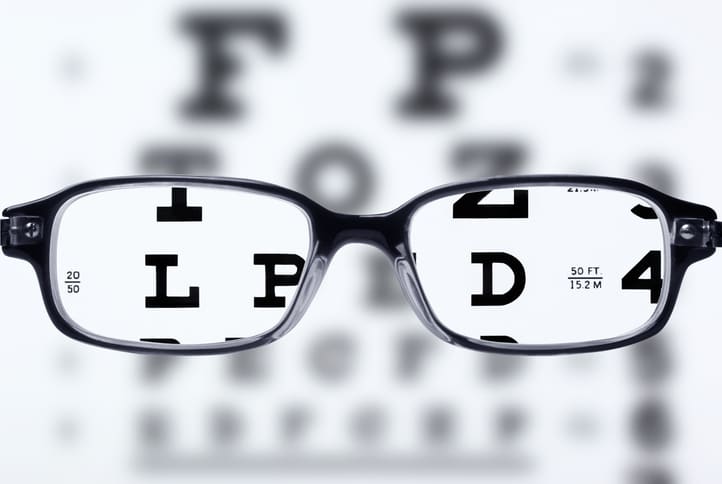Treating Astigmatism with Eyewear, Contacts, and Surgery
The American Optometric Association says that most people have some degree of astigmatism. This condition may be present from birth or develop later in life, and it can increase or decrease over time.
Astigmatism is defined as unequal curvatures in the shape of the cornea or lens. The cornea and lens focus light on to the retina, the area of the eye that sends light signals to the brain allowing us to see. This imperfection results in blurred vision.
If you think you might have astigmatism, or if you’ve recently been diagnosed with astigmatism, read on to learn more about some of the available astigmatism treatment options.
Types of Astigmatism
Astigmatism often occurs with myopia (nearsightedness) or hyperopia (farsightedness):
Myopic astigmatism
Light rays focus in front of the retina in the myopic eye, making objects in the distance blurred. Individuals who have myopia with astigmatism experience even worse blurring due to the refractive error caused by mismatched curvatures of the cornea or lens.
Hyperopic astigmatism
In people who are farsighted, the light focuses beyond the retina. Individuals with hyperopia and astigmatism experience blur the closer items become.
Mixed astigmatism
In people with mixed astigmatism, one curvature of the cornea or lens focuses light in front of the retina and the other focuses light behind the retina.
Signs and Symptoms of Astigmatism
To be diagnosed with astigmatism, you must be examined by your eye doctor. You’ll take visual acuity tests to determine if you are able to see clearly at various distances, and various instruments will be used to measure how your eyes focus.
Instruments used to diagnose astigmatism
The American Academy of Ophthalmology identifies three instruments that an eye doctor uses to measure astigmatism:
- Auto refractor – This tool measures how a light that is shined into your eyes changes as it refracts off the back of your eye.
- Topography machine/Keratometer – Measures the refraction of light from your cornea to determine the amounts of corneal curvature.
- Phoropter – This instrument contains a series of lenses that you look through to determine the amount of prescription needed to correct your vision.
Symptoms of astigmatism
Because the curvature of your cornea and lens differs from others who share the condition, the symptoms of astigmatism can differ from one sufferer to the next. Generally, the symptoms of astigmatism include:
- Starbursts at night
- Eye strain and/or squinting
- Blurry or fuzzy vision close up
- Difficulty seeing far away
- Headaches
Astigmatism Treatment Options: Corrective Lenses
Lenses (temporary) or refractive surgery (permanent) are used to correct astigmatism. If myopia or hyperopia are present in addition to astigmatism, these conditions must also be corrected.
Eyeglasses

Reading eyeglasses and eye chart
If you choose eyeglasses to correct your astigmatism, your prescription will include two measurements that are specific to astigmatism: cylinder and axis.
- Cylinder (CYL) is a measurement that indicates the lens power for astigmatism.
- Axis is measured in degrees from zero to 180 and refers to the position of astigmatism on the cornea.
If you are nearsighted or farsighted, you will also notice “sphere power” on your eyeglass prescription. The higher the number in your prescription, the more severe the condition. A plus sign indicates farsightedness and a minus is nearsightedness.
Contact Lenses
In the past, astigmatism was corrected with rigid contact lenses. Today, there are also soft toric contact lenses that correct astigmatism.
Toric contact lenses provide more comfort for patients with astigmatism and, according to the American Optometric Association, they also provide a “high degree of accuracy and producibility.” Toric lenses are made to bend light in a direction to correct astigmatism.
In more severe cases of astigmatism, an eye doctor may recommend a gas-permeable, rigid contact lens instead of soft toric lenses. Rigid lenses correct astigmatism by creating a spherical service on the surface of the eye.
A third option is Orthokeratology (Ortho-K) treatment. Patients wear Ortho-K rigid lenses for a period of time to reshape the cornea curvature. The correction will occur as long as treatment is ongoing. If treatment ceases, astigmatism will return.
Can LASIK Fix Astigmatism?
Yes, laser surgery can fully correct astigmatism and reduce or even eliminate the need for prescription lenses in most cases. However, the likelihood of a follow-up LASIK procedure increases with higher amounts of astigmatism.
New LASIK options are available for individuals with higher levels of astigmatism and myopia. Wavefront-Guided LASIK (WFG) uses an excimer laser that can normalize complex curvatures and irregularities on the cornea. The American Academy of Ophthalmology states laser ablation results in improved outcomes, including better night vision and fewer visual symptoms of astigmatism.
Femtosecond LASIK makes use of a femtosecond (FS) laser that creates incisions at a specific, pre-programmed depth in the cornea to correct refractive errors. The predictability of the procedure can provide outstanding results.
Is LASIK the Right Option to Correct Astigmatism?
If you live with astigmatism, you have the luxury of several excellent options to correct your vision. The best option is the one that you and your eye doctor choose to address your specific diagnosis.
LASIK is not recommended for everyone. If your cornea is too thin or your refractive error too high, you might not be a good candidate. Some patients need more than one procedure to correct all of their refractive errors. Your eye doctor will discuss what is best for you.
If you are looking for an eye doctor to talk to about surgical or corrective options for astigmatism, contact the eye care professionals at Barnet Dulaney Perkins Eye Center. Take our free vision correction self-evaluation to learn if you may be a good candidate for LASIK.

